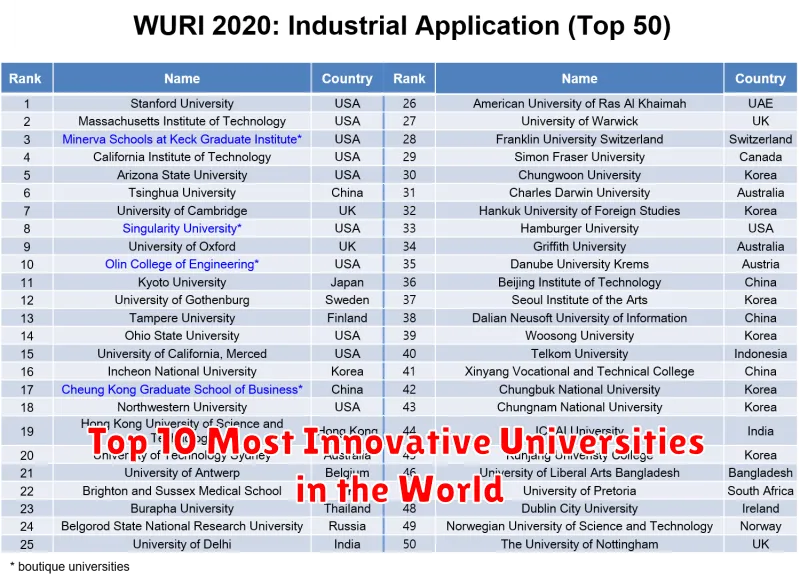In today’s rapidly evolving world, innovation is the key to progress. Universities, as centers of research and development, play a crucial role in driving this innovation. They are the breeding grounds for groundbreaking discoveries, technological advancements, and creative solutions to global challenges. This article will explore the top 10 most innovative universities in the world, institutions that consistently push the boundaries of knowledge and shape the future.
These top 10 universities represent the pinnacle of innovation in higher education. From pioneering research in fields like medicine, engineering, and artificial intelligence to fostering entrepreneurial ventures and impacting global policy, these institutions demonstrate an unwavering commitment to innovative thinking and impactful research. Join us as we delve into the remarkable achievements and contributions of these leading innovative universities, showcasing their groundbreaking work and their influence on the world stage.
How Innovation Is Measured
Measuring innovation is a complex process, as it encompasses various aspects of creativity, impact, and implementation. A common approach uses a combination of quantitative and qualitative indicators.
Quantitative measures often involve analyzing metrics such as:
- Number of patents filed and granted.
- Spin-off companies created.
- Research funding secured.
- Publications in high-impact journals.
Qualitative assessments can include:
- Expert reviews of research quality and potential impact.
- Industry partnerships and collaborations.
- Development of novel solutions to real-world problems.
- Contribution to advancements in specific fields.
Different ranking organizations may weigh these factors differently, leading to variations in how innovation is perceived and measured across various university rankings.
Stanford University

Located in the heart of Silicon Valley, Stanford University consistently ranks among the world’s most innovative institutions. Its close proximity to major tech companies fosters a dynamic environment of collaboration and entrepreneurship.
Key Strengths:
- Interdisciplinary Approach: Stanford encourages collaboration across departments, leading to groundbreaking research and innovative solutions.
- Entrepreneurial Ecosystem: The university has a strong track record of successful startups and spin-off companies, fostered by resources like the Stanford Research Park.
- World-Class Faculty: Stanford attracts leading scholars and researchers across various fields, contributing to a vibrant intellectual community.
Stanford’s commitment to innovation extends beyond the technological realm, impacting areas like medicine, education, and the humanities.
Massachusetts Institute of Technology (MIT)

The Massachusetts Institute of Technology (MIT) consistently ranks among the most prestigious and innovative universities globally. Located in Cambridge, Massachusetts, MIT is renowned for its strong emphasis on STEM fields, including engineering, computer science, and physical sciences.
MIT’s culture of innovation is fostered through extensive research opportunities, cutting-edge facilities, and a collaborative environment. The institute boasts numerous Nobel laureates among its faculty and alumni, a testament to its commitment to academic excellence. MIT’s impact extends beyond academia, with its graduates contributing significantly to advancements in technology, entrepreneurship, and various other fields.
Key areas of strength include:
- Artificial Intelligence: MIT’s Computer Science and Artificial Intelligence Laboratory (CSAIL) leads groundbreaking research in AI and machine learning.
- Biotechnology and Biomedical Engineering: The Koch Institute for Integrative Cancer Research at MIT is at the forefront of developing innovative cancer treatments.
- Sustainability and Energy: MIT researchers are actively engaged in developing sustainable energy solutions and addressing climate change.
Harvard University

Established in 1636, Harvard University consistently ranks among the most prestigious and innovative institutions globally. Its rich history is intertwined with groundbreaking advancements across numerous fields.
Harvard’s commitment to research and development fosters a culture of exploration and discovery. The university’s extensive resources and world-renowned faculty attract top scholars and students, creating a vibrant intellectual community.
Key areas of innovation at Harvard include:
- Medical advancements: Harvard Medical School and its affiliated hospitals are at the forefront of medical research, pioneering new treatments and therapies.
- Technological innovation: The School of Engineering and Applied Sciences drives innovation in fields like artificial intelligence, robotics, and nanotechnology.
- Social sciences research: Harvard’s contributions to economics, political science, and sociology shape public policy and understanding of human behavior.
Harvard’s influence extends beyond academia, impacting global progress and shaping future leaders.
University of Tokyo

The University of Tokyo, often referred to as Todai, consistently ranks among the top universities in Asia and globally. A national university, Todai is known for its strong research focus and its contributions to a multitude of academic disciplines.
Todai boasts a diverse student body and faculty, fostering a vibrant intellectual community. Its extensive research facilities and partnerships with industry leaders provide students with unparalleled opportunities for learning and innovation.
Key areas of strength include medicine, engineering, law, and literature. The university’s commitment to cutting-edge research and its impact on global issues solidifies its position as a leader in higher education.
Tsinghua University, China

Located in Beijing, Tsinghua University consistently ranks among the top universities globally and is a powerhouse of innovation in China. Research and development are central to Tsinghua’s mission, with a strong emphasis on practical applications and societal impact.
Key strengths lie in engineering, computer science, and materials science. The university fosters a collaborative environment, partnering with industry leaders and government agencies to translate research into tangible solutions.
Tsinghua University’s commitment to interdisciplinary research encourages groundbreaking discoveries across various fields. Its state-of-the-art facilities and world-renowned faculty further contribute to its innovative ecosystem, driving advancements in areas like artificial intelligence, sustainable energy, and biomedical engineering.
University of Cambridge

Established in 1209, the University of Cambridge is a world-renowned institution consistently ranked among the top universities globally. Its rich history and commitment to groundbreaking research have cemented its place as a leader in innovation.
Cambridge fosters a collaborative environment where brilliant minds come together to tackle some of the world’s most pressing challenges. The university’s strengths lie in its diverse academic departments, spanning fields from science and technology to humanities and the arts.
Key areas where Cambridge has made significant contributions include:
- Artificial Intelligence and Machine Learning: Cambridge researchers are at the forefront of developing cutting-edge AI technologies.
- Medical Advancements: The university is a hub for medical research, making significant strides in areas like cancer treatment and drug discovery.
- Sustainability and Environmental Science: Cambridge is committed to finding solutions for a sustainable future through research and innovation in environmental science and policy.
Cambridge’s impact is amplified by its entrepreneurial ecosystem, fostering the development of numerous successful startups and spin-off companies. This culture of innovation continues to drive progress and solidify Cambridge’s status as a global leader.
University of Oxford

Established in the late 11th century, the University of Oxford is one of the oldest and most prestigious universities in the world. Its rich history and commitment to groundbreaking research have earned it a place among the most innovative institutions globally.
Oxford’s interdisciplinary approach fosters collaboration and knowledge exchange across various fields. Its renowned academics and state-of-the-art facilities attract top talent from around the world, driving cutting-edge advancements in areas such as medicine, engineering, and the humanities.
The university’s entrepreneurial ecosystem actively supports the commercialization of research discoveries, translating innovative ideas into real-world solutions and impacting society on a global scale. This dedication to impactful innovation further solidifies Oxford’s position as a leader in higher education and research.
Key areas of strength include:
- Medical Sciences: Pioneering research in areas such as cancer treatment and vaccine development.
- Engineering: Advancements in robotics, artificial intelligence, and materials science.
- Humanities: Exploring complex societal challenges and contributing to cultural understanding.
National University of Singapore (NUS)

The National University of Singapore (NUS) consistently ranks among the world’s leading universities. Its focus on innovation is evident in its multidisciplinary approach to research and education.
NUS fosters a vibrant ecosystem where groundbreaking discoveries are made across various fields. Key areas of strength include engineering, technology, medicine, and the sciences. The university actively encourages entrepreneurship and collaboration with industry partners, translating research into real-world solutions.
Its cutting-edge facilities and initiatives like the NUS Overseas Colleges program provide students with invaluable opportunities to gain global perspectives and experience in entrepreneurial settings. This approach helps nurture a new generation of innovators prepared to tackle global challenges.
EPFL, Switzerland

The École polytechnique fédérale de Lausanne (EPFL) consistently ranks among the world’s most innovative universities. Located in Lausanne, Switzerland, EPFL focuses heavily on scientific and technological advancements.
Key research areas include robotics, nanotechnology, and renewable energy. EPFL encourages a strong entrepreneurial spirit, fostering the development of startups and spin-off companies based on research conducted within its labs. This focus on practical application contributes significantly to its reputation for innovation.
The university’s interdisciplinary approach and close collaborations with industry partners facilitate the rapid translation of research into real-world solutions. This creates a dynamic ecosystem where innovation thrives.
University of California, Berkeley

The University of California, Berkeley (UC Berkeley) is a public land-grant research university located in Berkeley, California. Established in 1868, it is the flagship institution of the University of California system and consistently ranks among the top universities worldwide.
UC Berkeley is renowned for its academic excellence across a wide range of disciplines, from engineering and computer science to humanities and social sciences. The university’s strong emphasis on research and innovation has led to groundbreaking discoveries and contributions in numerous fields.
Key strengths include its esteemed faculty, many of whom are Nobel laureates and other prestigious award winners; its diverse and vibrant student body; and its commitment to public service. UC Berkeley fosters a culture of intellectual curiosity and critical thinking, preparing graduates to become leaders and innovators in their chosen fields.

